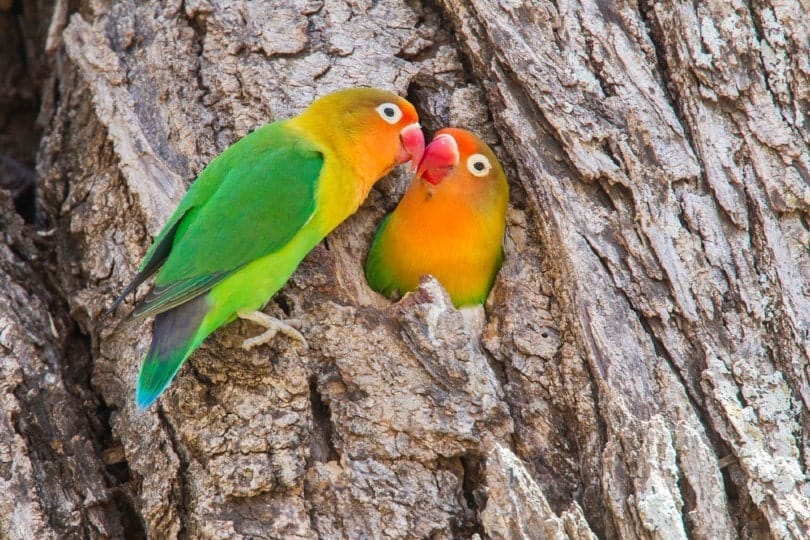The rewards of keeping a single lovebird can be astonishing. The amazingly determined spirit of a pet lovebird can far surpass other small parrots, both in their ability to learn tricks and to show affection. But because of their strong devotion, a lovebird kept singly will require vast amounts of time and affection in return in order to thrive.
| What’s in the name ? = Agapornis | ||
|---|---|---|
| agapein | means | “to love” in Greek |
| ornis | means | “bird” in Latin |
Lovebirds also won’t easily switch loyalties from one companion to another, whether it is to another bird or to another human. On the other hand, unless they are very attached to their keeper, lovebirds are not going to learn a lot of tricks or necessarily want to have a lot of handling.
If you simply want to enjoy the antics and chatter of these colorful little birds, get two to keep in an indoor cage. Or you can get more to keep in an aviary. They are very flamboyant, and are wonderful birds to observe and enjoy.
- See different Lovebirds and Lovebird Mutations in the Lovebird Types
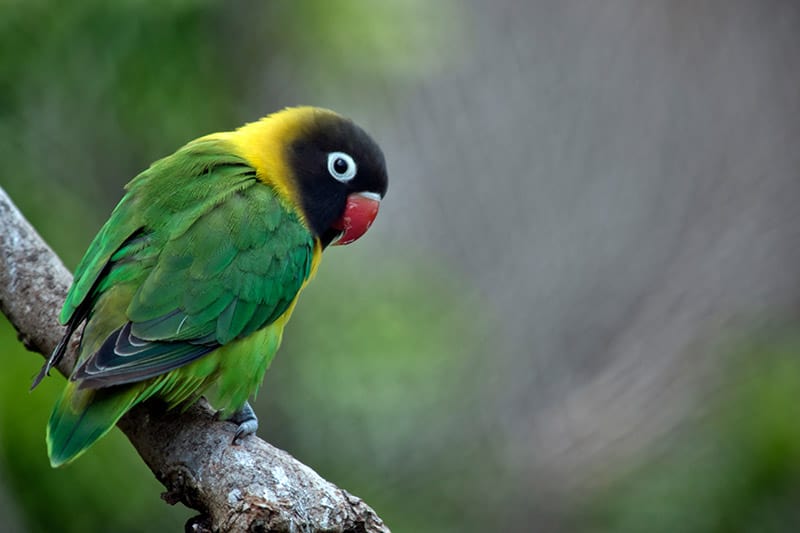
Distribution
Lovebirds belong to the genus Agapornis. There are nine species of lovebirds and they are all native to Africa except one. The exception is the Grey-headed Lovebird which comes from the island of Madagascar. Most lovebirds live close to the equator where they inhabit dry savannah regions. There is one exception, a forest dwelling lovebird, the Black-collared Lovebird.
Description
The lovebird is a small stocky parrot mostly between 5.1-6.7 inches (13-17 cm). They have a large bill and a tail that is either round or square. Their average life span is between 10-12 years with some living even longer. The lovebird has been recorded at 17 years and several people have reported their birds living even longer than that. We had one person state that their lovebird lived for 25 years!
The different species of lovebird are identifiable by their colors and markings. They vary greatly in their coloring, and each species can be viewed for their unique combinations. Younger birds are duller in color and they have black in their beaks. The young birds coloring intensifies as they reach maturity. Regardless of the species, mature lovebirds are gorgeous parrots.
Three of the nine lovebird species are most commonly available lovebirds for pets. The other six are more rare, and in some cases, absent at least in the United States. The three common species are the Peach-faced Lovebirds, the Masked Lovebirds, and the Fischer’s Lovebirds, and all three make wonderful pets. There are a variety of color mutations in lovebirds, developed from these three common species. This is especially true for the Peach-faced Lovebird, which can be bred in hundreds of different combinations of mutations. As a result, there are many new lovebird colors available.
A wide variety of lovebirds can be found in the pet industry and from breeders. Some lovebirds and lovebird mutations that are commonly available include:
- Abyssinian Lovebird
- Albino Lovebird
- Black Masked Lovebird
- Blue Masked Lovebird
- Dutch Blue Lovebird
- Fischer’s Lovebird
- Lutino Lovebird
- Peach-faced Lovebird
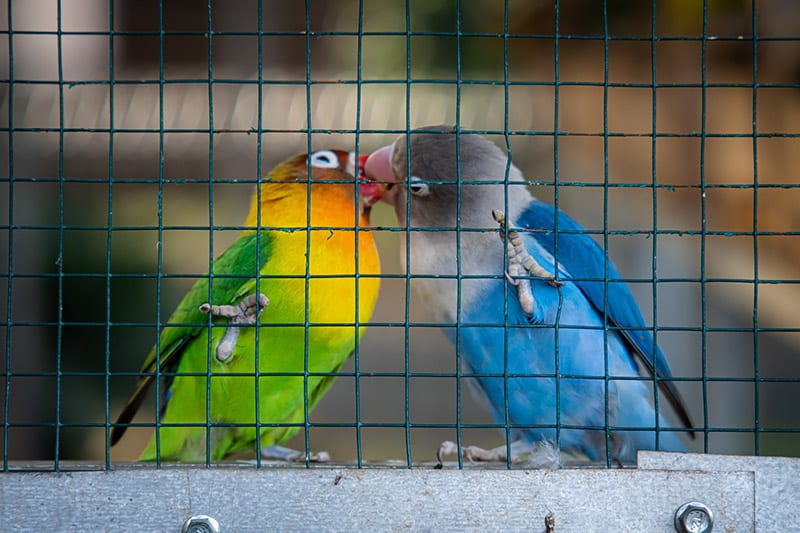
Care and feeding
In the wild, lovebirds feed on seeds, berries, fruits, grains, grasses, leaf buds, and agricultural crops of corn, maize and figs. Their food and water dishes are best if earthenware or porcelain as they will get gnawed if plastic.
Bird Food
Foods available for Lovebirds include formulated diets, either pelleted or extruded, seed only diets, and small parrot mixes which offer a mixture of both. There are pros and cons to feeding only a formulated diet as well as feeding only a seed diet.
Formulated Diet
A formulated diet provides a good nutritional base so does not require the addition of vitamins. However, it does not contain the phytonutrients (antioxidant pigments) that are found in vegetables, fruits, grains, and seeds. Phytonutrients are believed to boost the immune system, help a body to heal itself, and to prevent some diseases. Also, parrots can become bored with formulated diet due to the lack of variety.
Seed Diet
A seed-only diet offers much more variety but requires additional vitamin and calcium supplements. Lovebirds need not only nutritional requirements met but also variety for psychological enrichment.
A lovebirds’s diet will consist of 1 1/2 to 2 ounces (45-60 grams) of feed daily for a single bird. A diet consisting of a small parrot mix along with a variety of supplements and vitamins is generally regarded as suitable. Also a formulated diet along with greens, fruits, and vegetable supplements but without additional vitamins is also regarded as suitable, and is a more current trend.
Supplements
Supplements include fresh vegetables, greens, tree branches for the bark, some fruits, and millet spray. Some of the fruit supplements include berries, apples, grapes, pears, bananas, and kiwi. Some of the greens and vegetable supplements include spinach, endive, watercress, chickweed, radish, parsley, dandelions, carrot tops, corn on the cob, peas, endive, field lettuce, and various garden herbs.
Additional proteins can be offered such as nuts. Try some unshelled peanuts as well as hazelnuts, walnuts, Brazil nuts, and chestnuts.
A cuttlebone, or gravel and oyster shell in a separate dish can be offered to provide calcium. Do not feed avocado as it can be toxic to birds!
Vitamins can be added to the food or drinking water.
Water
Lovebirds drink a lot of water, so will need fresh drinking water every day.
Bird Baths
Most lovebirds love a bath either in a flat earthenware dish or by spraying them with a light mist of lukewarm water. If you use a bathing dish, you will see the birds perch on the edge and dip their heads and upper bodies in the water and beating their wings. They prefer this kind of bath to getting into the water.
Bird Grooming
Lovebirds generally maintain their nails and beaks on their own through climbing and chewing. Another good use they make of their tree branches.
You can find bird seed, bird cages, and everything you need for your pet here: Bird Supplies
Housing
Lovebirds are very active birds. When housing your lovebird, bird cages or an aviary best suited to them must provide a lot of space.
Bird Cages
A minimum of 32 x 20 x 20 (81 x 50 x 50 cm) per pair of birds is recommended with about four perches, feed and water dishes and an area for a bath. When you use a small cage, you must let your pet out daily to fly around.
If you are housing pairs of lovebirds here are a few guidelines: Try to house only one species of lovebird as mixing species can cause serious fights. House either one pair of lovebirds or three pairs, never two pairs or there will be fighting. Each pair needs about 35 cubic feet of space.
Bird Perch
Provide one or two perches about 3/4′ in diameter and dishes hanging from the side for feed, water, and grit. Try to place the perches away from dishes so the food and water dish do not become soiled with bird droppings. Do not use plastic because your bird will chew and break the plastic and it can become hazardous. Tree branches of a similar size make good perches and will help to wear the claws down naturally.
Bird Hide / Nest Box
Lovebirds like special resting places. Nest boxes placed up high, all at the same level and all of the same type work well and help prevent fights.
Aviary
A roomy indoor aviary, a bird room, or an outdoor aviary (depending on your area) are all good choices. The aviary needs plenty of light and fresh air. The outdoor aviary needs to have a protected shelter that can be heated and cooled where necessary. Flights are recommended to be a minimum of 6′ x 6′ x 3′ (183 x 183 x 91 cm) with plenty of perches or branches at least 1 1/2″ (15 cm) thick.
Maintenance
It is important For the health of your lovebird, it is important to keep bird houses and accessories clean and in good shape. Basic cage care includes daily cleaning of the water and food dishes. Weekly you should clean and disinfect the cage. Wash and completely dry the perches and toys whenever they become soiled. In the aviary, sand floors should be renewed annually.

Social Behaviors
Lovebirds as pets, as well as in the wild, are very social birds. Generally and in most situations, it is thought to be essential for their good health and happiness that they be kept in pairs, not singly. If keeping a single lovebird, you must provide the necessary social interaction that it is missing from another bird. These birds develop fierce loyalties to their keeper or their mate.
Aside from their social nature toward you or their mate, lovebirds can be extremely aggressive towards other birds. You must be certain that all pairs get along together, and that they are true “pairs”, not mismatched. Bonded pairs constantly groom each other and will feed each other from the crop during breeding season and all year round.
These little birds will chatter all day long. They will hide in their nest box if they are startled by a sudden noise, if they spot a potential predator, or if it gets cold and windy.
Handling/Training
Lovebird training is best accomplished with a young bird. To have a tame lovebird, its also best to work with a single bird. Young birds have an amazing ability to learn tricks and be affectionate. Adults on the other hand, are very difficult to tame and generally won’t learn a lot of tricks or imitate behaviors. Hand-raised youngsters are easiest to work with. They are already quite socialized and tame, but unfortunately they are not always available.
Taming involves acceptance and trust between you and your bird. It means spending a lot of time with your bird daily. Start with talking softly and making slow movements. Once your bird is comfortable with you, then you can begin hand-taming. Use a dowel and push it gently against the birds chest while offering a treat to coax it up onto the dowel. This may take many tries. Once it is comfortable with stepping up onto a dowel, substitute your finger for the dowel.
Lovebirds are not considered one of the best talkers, and only some may learn a few words.
Activities
Lovebirds awaken with the dawn, get a drink, eat, and then immediately begin to chirp. They will generally quiet down by mid-morning and resume their chirping in the late afternoon.
These birds are very active, flying and climbing about, gnawing on wood or chew toys, and grooming themselves many times all day. They love toys of all kinds such as seed bells, swings, ladders, mirrors, shiny objects, and wooden gnaws. A lovebird outside of it’s cage will not stay on it’s playpen, they like to explore. Be sure this room is safe with no open doors or windows, no toxic plants, no open water containers, and no hot stove.
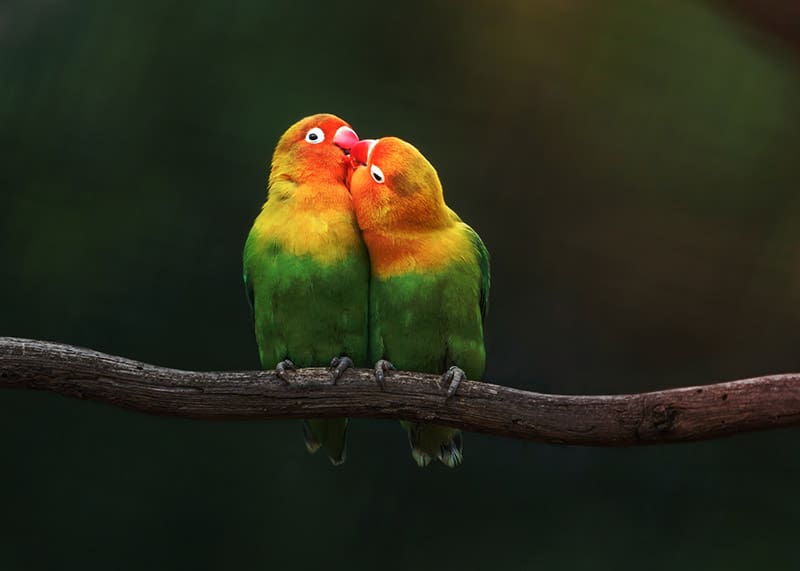
Breeding/Reproduction
One of the pleasures of lovebirds is that they are easy to breed. For breeding lovebirds, each pair of birds will need 2 nest boxes for sleeping and nesting. These boxes need to be of the same type and size, and placed at the same height on the same wall.
Breeding Lovebirds
Lovebirds will breed willingly as single pairs and some species of lovebirds can be bred in a colony setting. Especially suited to a colony are the white eye-ring group of lovebirds.
Breeding Age for Lovebirds
Lovebirds need to be at least 10 months old, though 12 to 13 months is better. Also birds that are 5 to 6 years or older should be retired from breeding.
Sexing Lovebirds
Some visual characteristics that may aid in determining sex are that the female is heavier bodied than the male and will sit more broadly with legs apart, while the males sit more upright. A females tail will appear more square while a males will appear more rounded. When observing the nesting behavior, the female will do most of the nest building work.
An anal inspection can be done but takes experience in sexing these birds to make a fair determination. Basically there are two bones called the ossa pubes on the ventral side of the pelvis and the female will be spread wider apart than the male.
The sexing of lovebirds falls into three categories:
Dimorphic Types – The first group are different in their outward appearance and can be classified as dimorphic. This first group consists of:
- Abyssinian Lovebird Agapornis toranta
- Madagascar Lovebird Agapornis cana
- Red-faced Lovebird Agapornis pullaria
Intermediate Types – The second or intermediate group are harder to differentiate by appearance. This group consists of:
- Peach-faced Lovebirds Agapornis reseicollis
- Black-collared Lovebird Agapornis swinderniana
Monomorphic Types – In the third group, the white eye-ring group, there are no definite differences that can be seen. The sexing of the white eye-ring group must be determined by either a surgical probe, endoscopy, which can be done by many veterinarians or by a DNA testing, usually a blood sample or a few plucked feathers sent to be diagnosed in a lab.
In the white eye-ring group are the:
- Masked Lovebirds Agapornis personata personata
- Fischer’s Lovebirds Agapornis personata fisheri
- Nyasa Lovebird Agapornis personata lilianae
- Black-cheeked Lovebird Agapornis personata nigrigenis.
Breeding Environment
If you are breeding lovebirds in a colony setting, it is very important to provide many more nest boxes than their are pairs of birds to minimize fighting. The nest boxes should all be the same and mounted at the same height of the enclosure. Also, be diligent in watching for fighting as it can lead to death.
A nest box for a lovebird is 8″ x 8″ x 8″ (20 x 20 x 20 cm) or 10″ x 6″ x 6″ (25 x 15 x 15 cm).
Egg Laying and Hatchlings
The female will lay about 5 eggs, though the clutch could be as few as 3 eggs or as many as 8 eggs. The incubation period is 22 – 25 days, with 75% to 80% of the eggs hatching. The hen will start to brood after the second egg is hatched. Often the male will join the hen in the nest. The chicks will begin to leave the nest in about 38 – 50 days and will be independent about 2 weeks after leaving the nest.
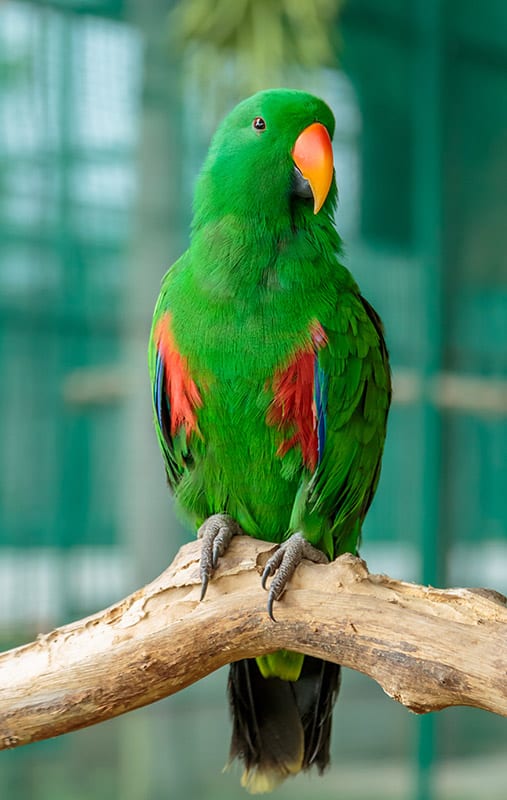
Potential Problems
Lovebird ailments, signs of illness to be aware of, include if a bird seems withdrawn, its feathers are ruffled and the plumage is dull, it sits with its eyes closed, watery or dull eyes, runny nose, it sleeps a lot, it looses interest in its environment, and it stays at its feed cup. The droppings may change color and be loose (if healthy they are grayish white and not to thin). A couple other lovebird ailments to watch for are a lot of tail bobbing, dropping off its perch, odd breathing, sneezing, and excessive scratching.
Some of the common lovebird ailments, illnesses your lovebirds could contract, are injuries from fighting, Psittacine Beak and Feather Disease, Polyoma Virus Infection, yeast infections (Candidiasis), Avian Pox Virus Infection, bacterial infections, internal parasites, mites, ticks, egg binding, intestinal influenza, coccidiosis, respiratory ailments, and diarrhea. An ailing parrot should be taken to a avian veterinarian for diagnosis and treatment.
Availability
The most available types of lovebirds for sale are the Peach-faced Lovebird, the Masked Lovebird, and the Fischer’s Lovebirds. There are many beautiful lovebird mutations developed from these three groups of birds that are also readily available. Many other species of lovebird are available but not be as readily found. Lovebirds are also fairly inexpensive little parrots.
Featured Image Credit: Danita Delimont, Shutterstock
